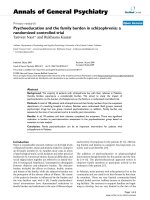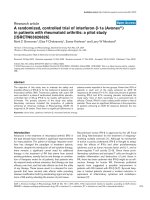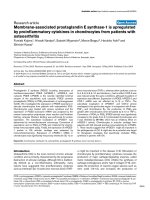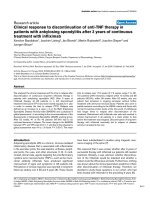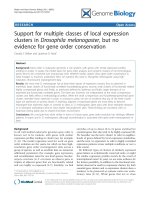Báo cáo y học: "Bench-to-bedside review: The importance of the precision of the reference technique in method comparison studies – with specific reference to the measurement of cardiac output" ppsx
Bạn đang xem bản rút gọn của tài liệu. Xem và tải ngay bản đầy đủ của tài liệu tại đây (405.25 KB, 6 trang )
Page 1 of 6
(page number not for citation purposes)
Available online />Abstract
Bland-Altman analysis is used for assessing agreement between
two measurements of the same clinical variable. In the field of
cardiac output monitoring, its results, in terms of bias and limits of
agreement, are often difficult to interpret, leading clinicians to use a
cutoff of 30% in the percentage error in order to decide whether a
new technique may be considered a good alternative. This percen-
tage error of ± 30% arises from the assumption that the commonly
used reference technique, intermittent thermodilution, has a
precision of ± 20% or less. The combination of two precisions of
± 20% equates to a total error of ± 28.3%, which is commonly
rounded up to ± 30%. Thus, finding a percentage error of less than
± 30% should equate to the new tested technique having an error
similar to the reference, which therefore should be acceptable. In a
worked example in this paper, we discuss the limitations of this
approach, in particular in regard to the situation in which the
reference technique may be either more or less precise than would
normally be expected. This can lead to inappropriate conclusions
being drawn from data acquired in validation studies of new
monitoring technologies. We conclude that it is not acceptable to
present comparison studies quoting percentage error as an
acceptability criteria without reporting the precision of the
reference technique.
Introduction
In 1986, Bland and Altman [1] first suggested their statistical
method for assessing agreement between two measure-
ments of the same clinical variable. They described the
‘Bland-Altman’ plot as a mechanism for displaying and
describing data from studies in which one variable is
measured by two different techniques. Since then, this ‘plot’
together with the associated analysis has become the
recognised statistical methodology for studies validating new
measuring or monitoring tools against a reference technique
[2,3]. The Bland-Altman plot is able to provide researchers
with a graphical representation of their data and also a
number of objective measures of how well the data series
agree with each other:
1. The bias: the average of all the differences.
2. The standard deviation around the bias.
3. The limits of agreement: the limits within which 95% of all
the points fall on either side of the bias (that is, ± 1.96
times the standard deviation around the bias).
These variables can be used to describe the accuracy and
precision of any given device. The accuracy describes how
close to the actual or real value the measurement is, whereas
the precision describes how close the values of repeated
measurements are. A good method should be both accurate
and precise. A visual example may clarify this point (Figure 1).
If we imagine a cardiac output monitor as a gun that is used
to shoot a target (the cardiac output), we can classify
accuracy as the characteristic of being able to shoot close to
the centre of the bull’s-eye. Precision is related to how close
repeated shots are to each other. How can we use these
concepts when looking at the Bland-Altman plot? First of all,
we have to imagine that our reference technique is very
reliable. Otherwise, the effect would be that of a ‘moving
target’. If the bias then is low, it means that the accuracy is
high. Limits of agreement refer to how precise the measure-
ments are. So if they are narrow, the precision is high; if they
are large, the precision is low. The bias therefore allows an
estimate to be made of the accuracy of the new device, and
the limits of agreement allow an estimate of the precision or
random error around the bias. An ideal result therefore would
have a very small bias with tight limits of agreement. These
Review
Bench-to-bedside review: The importance of the precision of the
reference technique in method comparison studies – with
specific reference to the measurement of cardiac output
Maurizio Cecconi
1,2
, Andrew Rhodes
2
, Jan Poloniecki
3
, Giorgio Della Rocca
1
and R Michael Grounds
2
1
Department of Anesthesia and Intensive Care, Azienda Ospedaliero Universitaria Udine, Piazzale Santa Maria della Misericordia, 33100 Udine, Italy
2
Department of Intensive Care Medicine, St George’s Hospital, London, SW17 0QT, UK
3
Community Health Sciences, St George's, University of London, SW17 0RE, UK
Corresponding author: Maurizio Cecconi,
Published: 13 January 2009 Critical Care 2009, 13:201 (doi:10.1186/cc7129)
This article is online at />© 2009 BioMed Central Ltd
CE = coefficient of error; CV = coefficient of variation; ITD = intermittent thermodilution; LSC = least significant change; OD = oesophageal
Doppler; PE = percentage error.
Page 2 of 6
(page number not for citation purposes)
Critical Care Vol 13 No 1 Cecconi et al.
descriptive terms are commonly used both to describe the
results of studies and to justify the conclusions. There is no
real consensus, however, in how these statistical terms relate
to any given variable and this has led to much confusion in
how to interpret studies and therefore in whether (or not) to
accept new measuring or monitoring devices into routine
clinical practice.
Validation of cardiac output monitoring devices
Ideally, any reference technique used should be able to
provide an accurate and precise measurement of cardiac
output. However, in clinical practice or human research, this
is rarely possible. The ideal reference method of measuring
cardiac output has not been described. However, the most
commonly used reference technique is an averaged set of
thermodilution curves taken from a pulmonary artery catheter.
This technique has been well studied and the level of
precision, if properly performed, is understood. In recent
years, there have been a large number of studies published in
which a new method of measuring cardiac output has been
assessed using intermittent thermodilution (ITD) from the
pulmonary artery catheter as the reference technique [4-10].
All of these studies have used the Bland-Altman methodology
to describe their data. In most studies, the results have
demonstrated a small bias but relatively wide limits of
agreement. For instance, Sander and colleagues [11] demon-
strated that, in comparison with ITD, the Vigileo/Flotrac
device (Edwards Lifesciences LLC, Irvine, CA, USA) had a
bias of 0.6 litres per minute and limits of agreement of
between –2.2 to +3.4 litres per minute. These results were
reported as demonstrating that the new tested device, the
Vigileo, was not a good measure of cardiac output compared
with the reference technique. However, it is not clear from
this paper, like many others reported before [12-14], what
would have been acceptable limits of agreement in order for
the study to confirm the efficacy of the new tool. To allow a
conclusion to be drawn from the data, the authors should
have made an a priori description of what they perceived to
be acceptable limits of agreement. Unless this is described
before the study is commenced, it becomes very difficult to
make sensible conclusions from the data.
To understand how wide the limits of agreement may be, it is
important to understand that with the Bland-Altman plot it is
possible to assess two independent methods of measuring
the same variable, each of which has its own inherent error.
The limits of agreement describe the variance around the
bias, which is in itself an averaged value taken from each pair
of study measurements. The limits of agreement also relate to
the population being studied. For instance, if the limits of
agreement are ± 1 litres per minute, this would be good for a
hyperdynamic population of patients with a mean cardiac
output of 10 litres per minute, but not so good for a paediatric
population with a mean cardiac output of 2 litres per minute.
Critchley and Critchley [15], in their meta-analysis of cardiac
output validation studies, suggested a solution to this
problem. They proposed that the percentage error (PE) of the
limits of agreement, as compared with the population mean,
be used to describe the agreement and that this could be
used as a cutoff for whether to accept a new technique [15].
The basis of this approach is that, in order to accept the new
technology (unless it heralds other significant advantages),
the level of accuracy and precision should at the very least
equal that of the reference technique. In statistical terms, the
random error that produces imprecision from a single
measurement is described by the coefficient of variation (CV).
This is calculated as the standard deviation divided by the
mean. When more than one measurement is used to produce
the overall result (for instance, when averaging three
thermodilution curves), the coefficient of error (CE), as
calculated from the following equation, is more appropriate:
CE = CV / √n (1)
where CE = coefficient of variation of average of n measure-
ments, CV = coefficient of variation of single measurements,
and n = number of repeated measurements.
When one only measurement is used, the CE is equal to the
CV. The precision of the technique is considered to be two
Figure 1
Bull’s-eye representation of accuracy and precision. With respect to
the Bland-Altman plot, accurate measurements mean small bias and
precise measurements mean narrow limits of agreement.
Page 3 of 6
(page number not for citation purposes)
times the CV or two times the CE. From now on, we will refer
to 2CV or to 2CE as precision. Critchley and Critchley [15]
looked at studies assessing oesophageal Doppler (OD)
ultrasound techniques as a measurement of cardiac output.
They compared these against ITD cardiac output from the
pulmonary artery catheter, which they described as having a
precision of ± 20%. They suggested that, in order for the new
device (Doppler) to be accepted, it should have an equivalent
precision (that is, 20%). Therefore, the PE from the Bland-
Altman plot, taken from the following equation, should be less
than 28.3% [15]:
CV
a – b
= √ [(CV
a
)
2
+ (CV
b
)
2
] (2)
where CV
a – b
= CV of the differences between the two
methods, CV
a
= CV of method a, and CV
b
= CV of method b.
This has been simplified by many authors to be a
requirement that a new technology have a PE from the
Bland-Altman plot of less than ± 30% [10,15-17]. In our
opinion, it is quite clear that this ± 30% margin for the PE
hides some important information and, if used without
understanding the background behind it, may lead to
erroneous conclusions being drawn from study results. The
30% limit is contributed to by two separate levels of
precision, which when combined add up to this value of ±
30% error. It should be intuitive, therefore, to understand
that the precision of the reference technique is extremely
important when assessing the combined error of the two.
This has been studied extensively with ITD and the variance
can range from 5% to 15% depending on the technique
used. The main limitation of this ± 30% cutoff, therefore, is
that it relies on the fact that the precision of ITD is always the
same and is usually around ± 20%. If the reference
technique is performed with a high degree of rigour, its
precision may actually be significantly less than the 20%
allowed for in the above equation. This may lead to the
acceptance of a studied technique with an inappropriate
level of precision. It is obvious that there is a relationship
between the two individual errors and the combined sum
(Figure 2).
If:
Precision for method a, precision
a
, 2 × CV
a
Precision for method b, precision
b
, 2 × CV
b
Percentage error is PE
a-b
= 2CV
a – b
Then:
PE
a-b
= √ [(precision
a
)
2
+ (precision
b
)
2
] (3)
If:
PE
a-b
from the Bland-Altman plot is known and precision
a
is
known,
Then:
Precision
b
= √ [(PE
a-b
)
2
– (precision
a
)
2
]
Therefore, we would suggest that, in any study in which a
new technique is to be validated against a reference, the
precision of the reference technique within the study be
measured and quoted, thus enabling an estimation of the new
technique to be made. Then whatever reference technique is
used in studies assessing a new cardiac output monitor,
there should always be a description of the error of that
technique as obtained within the study. These concepts hold
true for any study assessing a new methodology of
measurement against a reference in clinical science.
Worked example
Table 1 describes data taken from two independent measures
of cardiac output (A and B). The average cardiac outputs by
the reference technique and test technique were 8.0 and
8.2 litres per minute, respectively. The average of these was
8.1 litres per minute. In this example, measurements were
taken at times of stable haemodynamic situations and the
reference technique was ITD from a pulmonary artery
catheter measured from four independent and averaged
curves. The standard Bland-Altman plot is described in
Figure 3. The bias between the two techniques is 0.2 litres
per minute with limits of agreement around the bias of
± 2.5 litres per minute. This provides a PE for the agreement
between the two techniques of ± 30%. At first glance, this
would suggest that the new technique almost fulfills the
criteria to be within a ± 30% error rate. If the monitor has
other advantages (perhaps being less invasive, cheaper, and
easier to set up), this may be considered adequate for normal
practice. However, to understand the precision of the new
technique, it is necessary to look more carefully at the
Available online />Figure 2
Different combinations of precision for a reference and a new method
that can lead to a percentage error (PE) of 30%. A 30% PE can derive
from several combinations of precisions for the two methods
compared.
precision of the reference. In this example, as technique A
was ITD, four measurement curves were performed enabling
the CE of this technique under the study conditions to be
calculated: 4% for four averaged curves. By using equation 2
(as described above), it is then possible to calculate the CV
of the tested device, which in this case is 15%. It is then
obvious that, although the combined PE is almost adequate,
the precision of the new technique is more than three times
worse than the reference that it is attempting to replace.
For the purposes of this example, it is helpful to envision the
situation of the reference technique (ITD) being performed at
a number of differing levels of precision. For example, if the
comparison is done with one curve with a CV of 9%, then for
a studied technique with an error of 15% the PE from the
Bland-Altman plot is 34%, which according to the Critchley
and Critchley criteria is not acceptable (Table 2). On the
other hand, if the reference technique uses an average of four
curves (CE of 4%), then for the same technique as before
(error of 15%) the PE for the Bland-Altman plot is ± 30%,
which according to the Critchley and Critchley criteria would
be acceptable (Table 2 and Figure 4).
Clinical implications of understanding the
error for a cardiac output monitoring device
The understanding of how precise a monitor is allows us to
appreciate two important concepts. The first relates (as
discussed above) to how one monitor compares with another
in terms of accuracy, and the second relates to how the
monitor performs in normal clinical practice. If we assume that
the CE for ITD in normal clinical practice is 10%, what does it
tell us? For an individual patient, a CE of 10% implies that the
exact value of cardiac output lies with 95% certainty some-
where in a band between ± 20% (two times the error) of the
measured level. It is especially important to understand the
precision of these new tools when using them to target fixed
resuscitation endpoints (for instance, perioperative haemo-
dynamic optimisation protocols that aim to target an absolute
value of oxygen delivery index of 600 mL/min*m
2
[18,19]). An
error of 15% would mean that the measured cardiac output
Critical Care Vol 13 No 1 Cecconi et al.
Page 4 of 6
(page number not for citation purposes)
Table 1
Cardiac output in 20 patients: repeated measurements with the reference technique and single test measurements
Patient CO1, L/min CO2, L/min CO3, L/min CO4, L/min Mean CO, L/min CV, ± % CE, ± % Studied CO, L/min
1 6.5 8.8 7.0 7.7 7.5 13 7 6.9
2 11.8 15.1 14.3 12.8 13.5 11 5 10.9
3 7.8 6.7 6.5 6.6 6.9 9 4 6.7
4 7.0 7.3 6.5 7.1 7.0 5 2 8.2
5 6.1 6.7 7.6 6.5 6.7 9 5 5.9
6 13.2 14.4 12.8 13.6 13.5 5 3 14.2
7 13.1 11.7 14.7 13.3 13.2 9 5 11.9
8 6.1 6.3 6.6 7.4 6.6 9 4 7.3
9 16.2 12.7 13.3 14.4 14.2 11 5 13.8
10 5.2 5.2 3.9 5.6 5.0 15 7 6.0
11 6.8 7.4 6.1 6.4 6.7 8 4 7.1
12 8.2 7.7 8.2 7.6 7.9 4 2 7.4
13 6.7 5.5 6.9 5.8 6.2 11 5 6.8
14 3.9 4.3 4.7 5.0 4.5 11 5 3.9
15 6.1 6.6 6.7 4.9 6.1 14 7 7.8
16 8.0 8.5 8.0 8.2 8.2 3 1 10.2
17 8.0 6.9 7.5 8.1 7.6 7 4 9.4
18 7.0 6.3 7.5 6.5 6.8 8 4 5.6
19 8.2 7.5 8.8 8.3 8.2 7 3 10.1
20 4.5 3.9 4.1 4.6 4.3 8 4 4.5
Average 8.0 8.0 8.1 8.0 8.0 9 4 8.2
Mean cardiac output (CO) is the mean of the four measurements. CV is the coefficient of variation for a single measurement, and CE is the
coefficient of error when four measurements are averaged. The studied CO is the single measurement for the studied technique.
of 4.5 litres per minute could be anything from 3 to 6 litres
per minute (95% confidence). This may have profound
clinical implications.
In many clinical situations, there is no ‘normal’ cardiac output
for any individual patient at any specific time point. Most
clinicians, therefore, use these devices to see how the
physiology of the patient changes following an intervention. A
standard technique would be to perform a fluid challenge
with the aim of increasing the cardiac output by 10% from the
baseline value. It is obvious that, in order for a monitor to be
used to detect this 10% change, it must have a level of
precision that can detect this change and this is traditionally
done with 95% certainty. Measuring a change, however,
does not necessarily mean that the physiological status of the
patient has changed. The error of the measuring technique is
directly related to the magnitude of the least significant
change (LSC). The LSC is the minimum change that needs to
Available online />Page 5 of 6
(page number not for citation purposes)
Figure 3
Bland-Altman plot for new technique versus reference technique.
Dotted lines represent bias and limits of agreement. Data from Table 1
are used.
Figure 4
Precision of the reference technique for n averaged measurements and
the corresponding percentage error (PE) from the Bland-Altman plot
for a fixed level of precision of the studied technique (29%). The PE
can change simply by using a more or less precise reference
technique, even when the precision of the studied technique is not
changed. This may lead to the acceptance of a studied technique even
though its performance in terms of precision stays the same. CE,
coefficient of error.
Table 2
Effect of the number of measurements of the reference technique on the percentage error
Measurements for the
reference technique, Ref precision, Study precision, PE, ± 30%
number ± percentage ± percentage ± percentage fulfilled
1182934No
2122932No
3102931No
4 9 29 30 Yes
5 8 29 30 Yes
6 7 29 30 Yes
7 7 29 30 Yes
8 6 29 30 Yes
‘Measurements for the reference technique’ means the number of measurements averaged for the reference technique. ‘Ref precision’ is the
precision for the reference technique according to the number of averaged measurements, ‘study precision’ is the precision of the studied
technique as measured by the worked example, and PE is the percentage error for the Bland-Altman plot for the reference technique minus the
studied technique. The ‘± 30% fulfilled’ column shows whether the PE would be accepted according to a cutoff of 30%.
be measured by a device in order to recognise a real change
and can be described by the following equation:
LSC = precision √2.
This means that the usually accepted 10% CE for ITD would
allow measured changes to be trusted as real only if greater
than 28.3%. Understanding the error in single patients, there-
fore, will give us an estimate in the single patient of whether a
change has actually happened. Roeck and colleagues [20]
measured stroke volume before and after a fluid challenge
with ITD and with OD measured by two independent ob-
servers. There was a significant difference between the two
observers measuring the same change (if any happened at
all) and also between changes measured by the two tech-
niques. In their study, the error for ITD was 8% (clinically
acceptable) but, interestingly, was too high to consider
measured changes of less than 22% in magnitude [20]. This
may explain why the variation with the OD before and after
the fluid challenge was higher than the ones recorded by ITD.
As the authors stated, they found a higher-than-expected
variability in the Doppler. This was to be expected from the
variability in the reference technique.
Recommendations for validation studies of new cardiac
output monitors
1. The reference technique should be as accurate and
precise as possible.
2. The precision of the reference technique should be
measured within the study.
3. The desired precision of the new technique should be
described a priori.
4. The bias and limits of agreement between the two
techniques should be quoted.
5. The precision of the new tested technique should be
calculated.
Conclusions
As new technologies come into the marketplace, the
requirement for validation studies will increase. To make a fair
and valid comparison between new tools and more traditional
‘gold standard’ reference techniques, it is necessary to have
a robust and sensitive mechanism for performing the studies
and analysing the data. The understanding of the precision of
a new device is vital prior to accepting it into clinical practice
and prior to using it for significant therapeutic interventions.
Therefore, measuring the error of the studied techniques
should always be performed when comparing two methods.
This approach can be used for any method comparison
provided that the variance within the individuals of at least
one of the methods can be estimated.
Competing interests
AR has received lecturing fees from Edwards Lifesciences LLC
(Irvine, CA, USA) and LiDCO (Sawston, Cambridge, UK). The
other authors declare that they have no competing interests.
References
1. Bland JM, Altman DG: Statistical methods for assessing agree-
ment between two methods of clinical measurement. Lancet
1986, 1:307-310.
2. Bland JM, Altman DG: Comparing methods of measurement:
why plotting difference against standard method is mislead-
ing. Lancet 1995, 346:1085-1087.
3. Bland JM, Altman DG: Measuring agreement in method com-
parison studies. Stat Methods Med Res 1999, 8:135-160.
4. Hamilton TT, Huber LM, Jessen ME: PulseCO: a less-invasive
method to monitor cardiac output from arterial pressure after
cardiac surgery. Ann Thorac Surg 2002, 74:S1408-1412.
5. Lichtenthal PR, Gordan D: Testing the safety of Baxter continu-
ous cardiac output monitoring system. J Clin Monit 1996, 12:
243-249.
6. Munro HM, Wood CE, Taylor BL, Smith GB: Continuous inva-
sive cardiac output monitoring—the Baxter/Edwards Critical-
Care Swan Ganz IntelliCath and Viligance system. Clin
Intensive Care 1994, 5:52-55.
7. Della Rocca G, Costa MG, Pompei L, Coccia C, Pietropaoli P:
Continuous and intermittent cardiac output measurement:
pulmonary artery catheter versus aortic transpulmonary tech-
nique. Br J Anaesth 2002, 88:350-356.
8. Goedje O, Hoeke K, Lichtwarck-Aschoff M, Faltchauser A, Lamm
P, Reichart B: Continuous cardiac output by femoral arterial
thermodilution calibrated pulse contour analysis: comparison
with pulmonary arterial thermodilution. Crit Care Med 1999,
27:2407-2412.
9. Button D, Weibel L, Reuthebuch O, Genoni M, Zollinger A, Hofer
CK: Clinical evaluation of the FloTrac/Vigileo system and two
established continuous cardiac output monitoring devices in
patients undergoing cardiac surgery. Br J Anaesth 2007, 99:
329-336.
10. Mayer J, Boldt J, Schollhorn T, Rohm KD, Mengistu AM, Suttner S:
Semi-invasive monitoring of cardiac output by a new device
using arterial pressure waveform analysis: a comparison with
intermittent pulmonary artery thermodilution in patients
undergoing cardiac surgery. Br J Anaesth 2007, 98:176-182.
11. Sander M, Spies CD, Grubitzsch H, Foer A, Muller M, von
Heymann C: Comparison of uncalibrated arterial waveform
analysis in cardiac surgery patients with thermodilution
cardiac output measurements. Crit Care 2006, 10:R164.
12. Barin E, Haryadi DG, Schookin SI, Westenskow DR, Zubenko
VG, Beliaev KR, Morozov AA: Evaluation of a thoracic bioim-
pedance cardiac output monitor during cardiac catheteriza-
tion. Crit Care Med 2000, 28:698-702.
13. Neviere R, Mathieu D, Riou Y, Chagnon JL, Wattel F: Non-inva-
sive measurement of cardiac output in patients with acute
lung injury using the carbon dioxide rebreathing method. Clin
Intensive Care 1994, 5:172-175.
14. Jakobsen CJ, Melsen NC, Andresen EB: Continuous cardiac
output measurements in the perioperative period. Acta Anaes-
thesiol Scand 1995, 39:485-488.
15. Critchley LA, Critchley JA: A meta-analysis of studies using
bias and precision statistics to compare cardiac output mea-
surement techniques. J Clin Monit Comput 1999, 15:85-91.
16. Pittman J, Bar-Yosef S, SumPing J, Sherwood M, Mark J: Contin-
uous cardiac output monitoring with pulse contour analysis: a
comparison with lithium indicator dilution cardiac output
measurement. Crit Care Med 2005, 33:2015-2021.
17. Bein B, Worthmann F, Tonner PH, Paris A, Steinfath M, Hed-
derich J, Scholz J: Comparison of esophageal Doppler, pulse
contour analysis, and real-time pulmonary artery thermodilu-
tion for the continuous measurement of cardiac output. J Car-
diothorac Vasc Anesth 2004, 18:185-189.
18. Pearse R, Dawson D, Fawcett J, Rhodes A, Grounds RM, Bennett
ED: Early goal-directed therapy after major surgery reduces
complications and duration of hospital stay. A randomised,
controlled trial [ISRCTN38797445]. Crit Care 2005, 9:R687.
19. Boyd O, Grounds RM, Bennett ED: A randomized clinical trial of
the effect of deliberate perioperative increase of oxygen
delivery on mortality in high-risk surgical patients. JAMA
1993, 270:2699-2707.
20. Roeck M, Jakob SM, Boehlen T, Brander L, Knuesel R, Takala J:
Change in stroke volume in response to fluid challenge:
assessment using esophageal Doppler. Intensive Care Med
2003, 29:1729-1735.
Critical Care Vol 13 No 1 Cecconi et al.
Page 6 of 6
(page number not for citation purposes)

